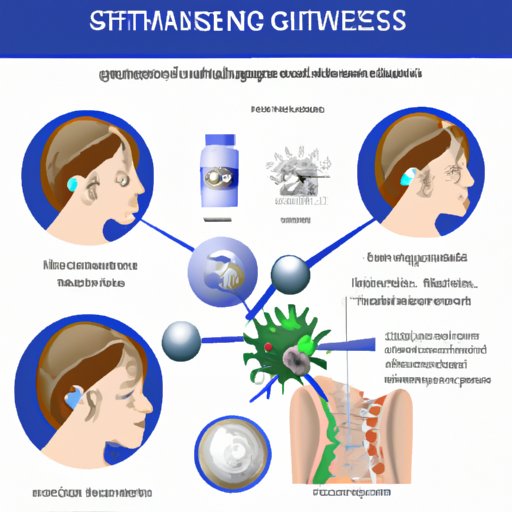
I. Introduction
Myasthenia gravis is not a widely known disease, but it affects a significant number of people worldwide. Understanding the mechanisms, symptoms, diagnosis, and treatment options can help individuals better learn to cope with this illness. This article delves into the connection between myasthenia gravis and autoimmune diseases.
II. Defining Myasthenia Gravis: An Autoimmune Disease
Myasthenia gravis is an autoimmune disease that affects the communication between muscles and nerves, leading to muscle weakness and fatigue. The body’s immune system attacks and weakens muscles due to communication issues between muscles and nerves. It is a relatively rare disorder, affecting all age groups and ethnic backgrounds and is often misdiagnosed or overlooked entirely.
III. Understanding the Mechanisms of Myasthenia Gravis as an Autoimmune Disorder
Myasthenia gravis develops when antibodies disrupt the receptors on muscle cells that receive signals from nerves. The antibodies responsible for disrupting these receptors are called acetylcholine receptor antibodies (AChR). Another culprit behind the disorder is muscle-specific kinase antibodies (MuSK), responsible for blocking acetylcholine receptors. Both types of antibodies lead to communication difficulties between muscles and nerves, leading to weakness and fatigue. Genetics and environmental triggers such as stress and infections contribute to the disorder. Myasthenia gravis shares some of its features and symptoms with other autoimmune diseases such as lupus and rheumatoid arthritis.
IV. Symptoms, Diagnosis, and Treatment Options for Myasthenia Gravis, an Autoimmune Disease
The most common symptoms of myasthenia gravis include difficulty swallowing, breathing, and speaking, as well as drooping eyelids and double vision. Diagnosis is made through blood tests to measure AChR and MuSK antibodies or imaging studies to look for abnormalities in the thymus gland. Treatment options include immunosuppressive therapy, plasmapheresis, and supportive medications such as anticholinesterase drugs.
V. Current Research on the Link between Autoimmune Diseases and Myasthenia Gravis
In recent years, research has found a link between myasthenia gravis and other autoimmune diseases such as thyroid disease, rheumatoid arthritis, and lupus. Early diagnosis of autoimmune diseases, including myasthenia gravis, can prevent the onset of other autoimmune conditions. There is ongoing research to study experimental treatments and breakthroughs that could benefit myasthenia gravis patients.
VI. Living with Myasthenia Gravis: A Personal Account of an Autoimmune Disease
Living with myasthenia gravis can be challenging, and a personal account of a patient can give insight into the day-to-day realities of the condition. Patients may experience difficulties performing routine activities such as bathing, dressing, and eating. Coping strategies include adapting daily routines, finding support, and participating in activities that help control stress levels. Online support groups and local organizations are also useful resources for coping with myasthenia gravis.
VII. The Role of Stress Management in Coping with Myasthenia Gravis, an Autoimmune Disease
Stress exacerbates myasthenia gravis symptoms, and it is essential to manage it effectively. Stress management techniques such as meditation, breathing exercises, and yoga can help patients better manage their symptoms. Self-care and support systems also play an important role in helping patients achieve a better quality of life. Patients should talk to their healthcare providers about strategies for managing stress related to their specific diagnosis.
VIII. Conclusion
Myasthenia gravis is an autoimmune disorder that affects the communication between muscles and nerves, leading to muscle weakness and fatigue. Individuals can better understand and cope with myasthenia gravis by learning about its mechanisms, symptoms, diagnosis, and treatment options. Early diagnosis is essential to prevent the onset of other autoimmune conditions. Coping strategies, stress management, and support systems also play vital roles in achieving a better quality of life for patients living with myasthenia gravis.





